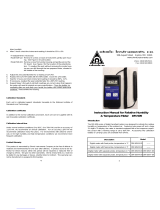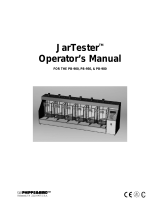
8 9
6. Locate the o-ring lubricant included with the new sensor cap.
Apply a thin coat of o-ring lubricant to the installed o-ring. After
application, there should be a thin coat of o-ring lubricant on the
o-ring only. Remove any excess o-ring lubricant from the o-ring
and/or probe with a lens tissue.
7. Clean the clear surface of the optical DO sensor window (figure 1)
with a lens cleaning tissue.
8. Remove the new sensor cap from its hydrated container and dry
the inside cavity of the sensor cap with lens tissue. Make sure that
the cavity is completely dry and clean before proceeding with the
installation. Using a clockwise motion, thread the new sensor cap
onto the probe assembly until it is finger-tight. The o-ring should
be compressed between the sensor cap and probe. Do not over-
tighten the sensor cap and do not use any tools for the installation
process.
9. Clean the stir paddle and then reinstall it on the probe by pushing
it straight into place.
10. Store the sensor in a BOD bottle with a small amount of water
(approximately 40 ml).
11. Enter the new Sensor Cap’s coefficients into the instrument. See the
instrument’s manual for more information on entering coefficients.
12. After entering the new Sensor Cap coefficients, perform a 1-point
DO calibration.
REHYDRATING THE SENSOR CAP
The Sensor Cap must remain in a moist environment for proper
operation; see Sensor Storage for storage recommendations. If you
inadvertently leave your sensor exposed to ambient air for a period
of more than approximately 8 hours it may dry out. If the sensor cap
is allowed to dry out, it is likely to drift slightly at the beginning of
your next study unless it is rehydrated. If the cap dries out, you can
rehydrate it by soaking the probe tip with the sensor cap installed in
warm (room temperature) tap water for 24 hours. After rehydration is
complete, perform a 1-point DO calibration and be sure to store the
probe in a moist environment.
SenSOr maintenance - temperatUre
You must keep the temperature portion of the sensor free of build
up. Other than that, the sensor requires no maintenance. A soft bristle
brush can be used to scrub the temperature sensor if needed. While
cleaning, be sure to only scrub the temperature sensor and not the
sensor cap. The sensor cap will be damaged if cleaned with anything
abrasive.
SenSOr StOrage
SHORT-TERM STORAGE
When the OBOD is not in use, it must be stored in a moist environment,
i.e., the sensor either immersed in water or in water-saturated air. If the
sensor cap is allowed to dry out by exposure to dry air, it is likely to drift
slightly at the beginning of its next use unless it is rehydrated. If this
occurs, follow the rehydrating instructions in this manual.
For short-term storage (<30 days), place the probe in a BOD bottle that
contains a small amount of clean water (approximately 40 ml). This will
provide a 100% water-saturated air environment.
LONG-TERM STORAGE
For long-term storage (>30 days), remove the batteries from the
instrument. Moisten the sponge in the protective plastic cap that was
originally provided with the probe with clean water. Place the clear
cap over the sensor with the sensor cap installed. Inspect the sponge
every 30 days to make sure it is still moist. If you no longer have the
protective cap, place the probe in a BOD bottle that contains a small
amount of clean water (approximately 40 ml). Or, you can place the
sensor with sensor cap installed directly in water in a BOD bottle.
Recommended Long-term Storage ambient
temperature: -5 to 50°C (23 to 122°F)
TROUBLESHOOTING
DiSSOlveD Oxygen reaDingS
Erroneous dissolved oxygen readings typically indicate a need to
clean the sensor cap, replace the sensor cap and/or recalibrate the
instrument.
First, verify that the instrument is measuring temperature accurately.
Both the DO % and mg/L measurements are temperature dependent
so if the temperature reading is incorrectly, the DO measurements will
also be erroneous.
If the DO% measurement is accurate but the mg/L value is incorrect,
check the salinity compensation setting in the instrument. The salinity
compensation value should be set to the salinity of the sample you are
testing. Municipal wastewater is typically 0 ppt.














